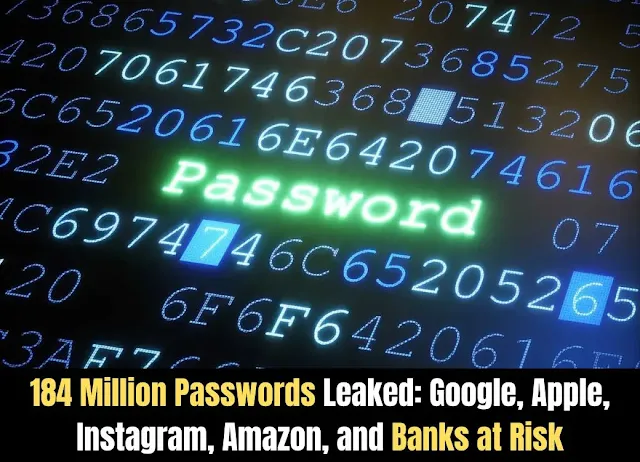A massive, unprotected database containing over 184 million login credentials—including passwords for services like Apple, Google, Instagram, Amazon, and even banking and government portals—has been discovered online.
In this post, we’ll break down what happened, which platforms are affected, how these credentials were stolen, and what you need to do right now to protect your accounts.
What Happened?
Cybersecurity researcher Jeremiah Fowler uncovered a publicly exposed server holding more than 184 million plain-text passwords along with usernames, email addresses, and direct login URLs to dozens of major online services.
The total dataset exceeds 47GB in size and includes credentials for:
- Apple, Google, Gmail, Outlook
- Instagram, Discord, PayPal
- Amazon, WordPress, and major cloud services
- Healthcare platforms, banks, and government portals
- Educational institutions across multiple countries
(ads)
Why This Is a Serious Threat
Unlike most data breaches where passwords are encrypted or hashed, this leak exposed passwords in plain text—with no encryption, no protection, and no security key. That means anyone who accesses this database can use the credentials instantly without cracking or decoding anything.
Jeremiah Fowler described the exposed server as a “goldmine for cybercriminals”, and rightly so. The database was completely open and accessible to anyone who found it.
How Were These Passwords Collected?
The leaked credentials appear to have been harvested using infostealers—a type of malware that infiltrates devices through:
- Pirated software downloads
- Malicious browser extensions
- Phishing emails and fake login pages
Once installed, infostealers extract sensitive data stored in browsers, email clients, messaging apps, and even system files—then send it back to remote servers controlled by hackers. (ads)
Who Is Behind the Leak?
As of now, the identity of the person or group operating the server remains unknown. Fowler reported that he was unable to confirm the server's owner but did alert the hosting provider to shut down the exposed system.
The scale of the breach and variety of services involved suggest that multiple sources and large-scale malware campaigns may have been used to collect this data.
Frequently Asked Questions
Q: Should I be worried if I use Google, Apple, or Instagram?
Yes. While it's unclear whose data was included, the presence of login URLs and unencrypted passwords means many mainstream users are likely affected.
Q: How can I check if my credentials were compromised?
Use trusted tools like Have I Been Pwned to check your email and password exposure. However, not all recent leaks are indexed immediately.
Q: What should I do right now?
- Change your passwords immediately—starting with your most sensitive accounts.
- Enable two-factor authentication (2FA) everywhere.
- Avoid reusing the same password across services.
- Run a malware scan on all devices.
Q: How can I protect myself in the future?
- Never download cracked or pirated software.
- Be cautious with unknown links or attachments.
- Use a password manager to generate and store strong, unique passwords.
- Regularly update your devices and software.
(ads)
Conclusion: Don’t Wait for the Next Breach
This isn't just a data leak—it’s a wake-up call. If your login details are out there in plain text, you’re at immediate risk of account takeover, identity theft, and financial loss.
With over 184 million credentials exposed, chances are high that someone you know—or maybe even you—have been compromised.
Take action now:
Change your passwords. Turn on 2FA. Review your account activity. And stay informed, because this won’t be the last major breach we hear about.


